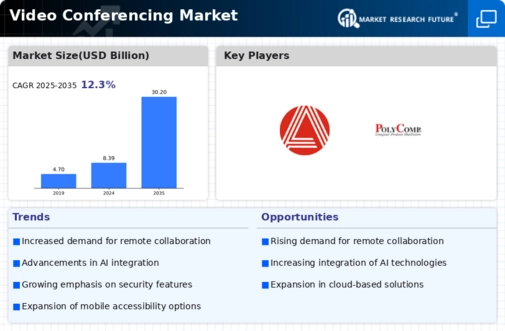Market Trends
Key Emerging Trends in the Video Conferencing Market
In this dynamic environment of the video conferencing market, companies employ various strategies to gain more shares. A basic approach revolves around technological innovation, wherein firms strive to develop and provide cutting-edge features and capabilities within their videoconferencing solutions so as to differentiate themselves from rivals in a competitive marketplace. Marketers use pricing strategies to position their product better within the target market so that it can be found by potential consumers easily without difficulty or any form of resistance against the purchasing decision-making process, hence leading to high sales volume for a given period span, for instance,, during holidays which lead increased profits through increased consumption rate (Cunningham & Bennett 2012). Collaboration and strategic partnerships come out as critical parameters for positioning market share in the Video Conferencing Market. These may involve alliances with platform integrators, hardware manufacturers, or specialized solution providers who serve specific industries, thus fostering greater integration and application opportunities for these company's conferencing solutions. Customer-centric strategies have been key drivers toward achieving higher market share in the Video Conferencing Market (Hill & Jones., 2013). By focusing on customer satisfaction through seamless user experiences, strong security measures, and responsive customer support, some firms have established long-term relationships. Positive client experiences contribute to customer loyalty, word-of-mouth recommendations, and a positive feedback loop for market share expansion. Companies that invest in research and development (R&D) to be ahead of technological trends can create new features such as AI-driven video enhancements, advanced meeting analytics, or augmented reality collaboration tools. Marketing communication mix, as well as branding, play an essential role in determining how much market share a company is going to have in this industry. This is achieved by building a strong brand identity and promoting it through targeted marketing campaigns; these increase visibility and credibility (Kotler, 2000). Therefore, companies need to participate in industry events and webinars or online forums where they can exhibit their knowledge base on topics related to their businesses. Geographic expansion is another strategic move that firms seek in the Video Conferencing Market. Through their presence in new regions or countries, companies can penetrate untapped markets, thereby expanding customer base breadth while reducing the overall risk caused by too much reliance on one particular market segment only. Doing this may entail forming alliances with local distributors, setting up regional offices, or making adjustments so that conferencing solutions appear consistent with languages spoken locally but still reflect best practices all over the world. At the same time, however, it must be noted that sustainability and environmental responsibility are now starting to influence marketing strategies adopted by companies when competing for market leadership positions within their respective industries. In order to make these customers more comfortable with them, many organizations today try being eco-friendly experts using remote work instead of traveling through emission-causing transport systems like planes or riding bicycles, which produce fewer greenhouse gases than cars would do at any given point during the year particularly considering its usage frequency among people living area lacking good public transportation system US Market.





Leave a Comment